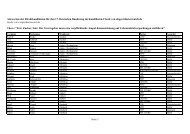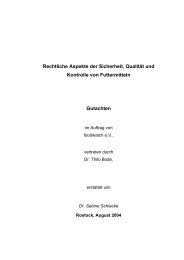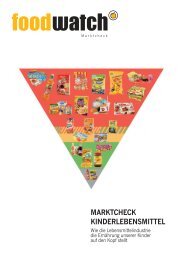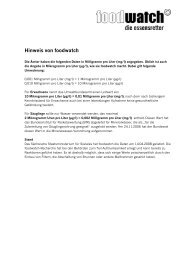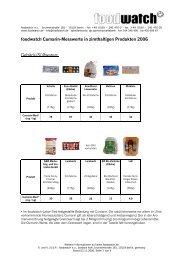Ökobilanz von Danone Activia-Verpackungen aus ... - Foodwatch
Ökobilanz von Danone Activia-Verpackungen aus ... - Foodwatch
Ökobilanz von Danone Activia-Verpackungen aus ... - Foodwatch
Erfolgreiche ePaper selbst erstellen
Machen Sie aus Ihren PDF Publikationen ein blätterbares Flipbook mit unserer einzigartigen Google optimierten e-Paper Software.
150 <strong>Ökobilanz</strong> <strong>von</strong> <strong>Danone</strong> <strong>Activia</strong>-<strong>Verpackungen</strong> 2011 IFEU Heidelberg<br />
Data from the analysis of corn yield and land use reveals the relative significance of<br />
this carbon fixation in the soil through conservation tillage practices. The average<br />
corn yield in the twenty-six counties serving the corn wet mill was 0.86 kg/m 2 . The<br />
carbon dioxide fixed by the corn grain is 1,420 g/kg corn or 1,420 x 0.86 = 1,221<br />
g/m 2 . This means that the carbon dioxide „fixed‟ by carbon sequestration in the soil is<br />
about 5% (59/1,221 x 100) of the carbon dioxide fixed by the corn grain itself.<br />
Kim (Kim 2004a) calculated soil organic carbon sequestration for continuously grown<br />
corn under no-tillage conditions for a period of 40 years in 14 counties situated in<br />
seven major corn production states. Results from the DAYCENT model showed that<br />
carbon sequestration rate range from 138 to 250 g CO2/m 2 /year. Sheehan (Sheehan<br />
2003) calculated with the CENTURY model carbon sequestration over a period of 95<br />
years in a continuous corn, no till, no residue collection production system. Results<br />
showed a carbon sequestration rates of about 131 g CO2/m 2 /year. Both values (Kim<br />
and Sheehan) are higher than the no-till scenario (Case II) of Table 1. However, this<br />
value is determined for a corn-wheat-soybean rotation system.<br />
According to Dobermann (Dobermann 2004) one should be cautious about the<br />
potential for soil C sequestration in agricultural no-till systems. Most estimates come<br />
from long term experiments in which some form of conservation tillage is compared<br />
with no-till. In other words, they assume that carbon accumulates once land is<br />
changed to no-till. In most cases, the published carbon sequestration rates range<br />
from about 20 to 60 CO2-C/m 2 /y (or 73-220 g CO2/m 2 /y). He had not seen much<br />
convincing evidence that such rates have been achieved in absolute terms over<br />
larger land areas, under normal production conditions. The preliminary results of new<br />
studies on this, started in 2001, suggest that little C sequestration may occur in<br />
irrigated no-till systems, mainly bec<strong>aus</strong>e residue on the surface is decomposed<br />
quickly rather than transformed into stable soil humus. Not much evidence was seen<br />
for significant carbon accumulation under no-till over a period of 3 years after the<br />
fields had been disked. He recommended to be cautious about the potential for soil C<br />
sequestration in agricultural no-till systems. The greatest uncertainty remains for<br />
irrigated systems, i.e. most of the literature data published come from dryland/rainfed<br />
experiments or, in other papers, are simply simulated changes in soil C with no field<br />
verification.<br />
West (West 2002) reports that preliminary analysis suggests that, on average,<br />
conversion from conventional tillage to no-tillage in the US will result in a<br />
sequestration of 337 � 108 kg C/ha/yr (124 ± 11 g CO2/m 2 /yr) in agricultural soils, to<br />
a depth of 30 cm. This data is based on 76 long-term soil carbon experiments<br />
assembled by the Center for Research on Enhancing Carbon Sequestration in<br />
Terrestrial Ecosystems, US Department of Energy.<br />
Six et al. (Six 2004) compiled all available data of soil-derived GHG emission<br />
comparisons between conventional tilled and no-tillage systems for humid and dry<br />
Endbericht – Bearbeitungsstand 29. März 2011



